Battery safety boxes
Maximum fire protection with ZARGES Battery Cases
Lithium-Ion batteries are now an indispensable part of our everyday lives. However, their storage and transportation requirements need special precautions, as lithium battery fires are particularly dangerous and difficult to extinguish.
With ZARGES Battery Cases, we offer you a professional solution for maximum fire protection combined with simple handling. Our boxes are flexible, durable and robust. You can rely on ZARGES Battery Cases for fire protection and battery transportation.
Safety-tested
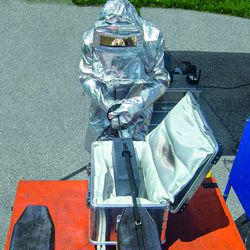
Our battery safe boxes are tested in our internal ZARGES test department and by recognised external testing institutes, such as TÜV NORD and BAM. They are subjected to real-fire and explosion tests to verify that no flames or debris escape.

The ZARGES Battery Case - Storage is the only battery storage box to have successfully complied with the stringent requirements of TÜV Nord for Safe Battery Storage Boxes.
Professional fire protection, combined with simple handling
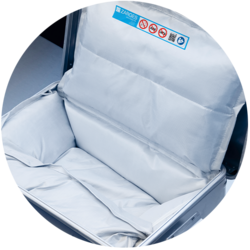
Fire-resistant interior lining
The fire-resistant material moulds itself to the contour of the batteries
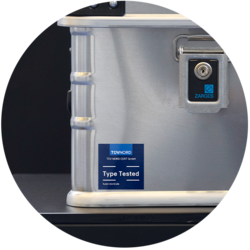
Sturdy aluminium box
Proven, durable ZARGES quality – lightweight
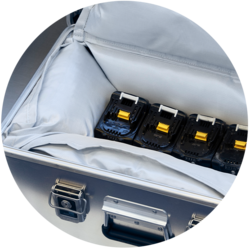
Interior can be used as required
Dimensions for each box are optimised according to usage
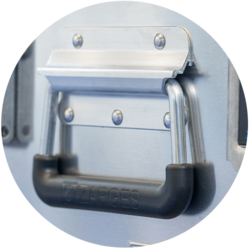
Sturdy comfort handles
Robust, wide handles for easy handling
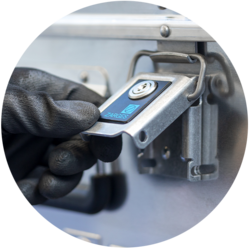
Ergonomic fasteners
Easy and efficient opening and closing

Made in Germany
All ZARGES boxes are manufactured in the Weilheim (Germany) plant
Battery Case product family
For a detailed comparison, please refer to the technical data.

Battery Case
Suitable for transporting and storing batteries up to 814 Wh
The spacious safety box for larger batteries, such as those used on e-bike and e-scooter.

Battery Case - Universal
Suitable for transporting and storing batteries up to 1384 Wh
The premium model for the highest safety requirements when transporting batteries.

Battery Case - Storage
Suitable for storing batteries
up to 814 Wh
The TÜV-certified battery storage box for assured fire protection.
For industrial, trade and distribution use
Whether for the storage or transportation of intact or defective batteries, find the optimal battery case to match your needs. A detailed overview of all ZARGES Battery Cases can be found in the technical data.

Battery Case offers ample storage space, even for longer e-bike batteries. Tested and approved in accordance with UN regulations for the transportation of hazardous and critically defective batteries up to 814 Wh.
Battery Case - Universal is our most robust battery case for the highest safety requirements when transporting lithium-ion batteries in accordance with UN regulations. Tested and approved for the transportation of critically defective batteries up to 1384 Wh.


Battery Case - Storage is the safe and secure storage of bicycle batteries as well as power tool batteries up to 814 Wh for industrial use, trade use and residential households.
“As a dealer specialising in hazardous goods applications, we have been successfully selling ZARGES battery cases for several years. In addition to the first-class cooperation, we and our customers particularly appreciate the quality, easy handling and, of course, the certified safety of the solutions. We are delighted that the Storage Box is now a certified addition to the Battery Case family."
Thomas Mahler, Managing Director, LionCare GmbH

Technical data
| Product code | Battery Case - 40582 | Battery Case - Universal - 40583 | Battery Case - Storage - 40584 |
| Suitable for storage of lithium-ion batteries | ✔ | ✔ | ✔ |
| Suitable for hazardous goods transportation of lithium-ion batteries | ✔ | ✔ | For use by private individuals and skilled workers as per the tradesmen’s regulation (ADR 1.1.3.1 c). |
| Application | Transportation and storage of lithium-ion batteries, for industrial, trade and distribution use. Designed especially for e-bike & e-scooter batteries. | Transportation and storage of Highest battery capacity with compact external dimensions. | Storage of lithium-ion batteries, for industrial, trade and distribution use. Suitable for transportation by domestic users and professionals who don’t need to meet regulatory requirements. |
| Key characteristic | Three separate compartments to prevent flames from spreading to adjacent batteries in case of a fire. | Additional heat shields provide increased thermal protection. | Safe storage solution. |
| Common features | A one-piece cushion; prevents handling errors and ensures maximum safety. | ||
| Battery condition - | |||
| Prototypes | ✔ | ✔ | ✔ |
| Intact series batteries | ✔ | ✔ | ✔ |
| Defective batteries | ✔ | ✔ | ✔ |
| Critically defective batteries | ✔ | ✔ | ✔ |
| Batteries for disposal and recycling | ✔ | ✔ | ✔ |
| Certified with nominal value (Wh) | 814 | 1,384 | 814 |
| Usable internal dimensions (mm) | 3 compartments each 500 × 150 × 180 | 390 × 190 × 100 | 450 x 300 x 150 |
| External dimensions (mm) | 600 x 600 x 250 | 600 x 400 x 250 | 600 x 400 x 240 |
| Net empty weight (kg) | 11.5 | 11.5 | 9 |
| Number of comfort handles | 2 | 3 | 3 |
| Material | Aluminium with a one-piece fire-resistant cushion. | Aluminium with one-piece fire-resistant cushion. | Aluminium with one-piece fire-resistant cushion. |
| Safety Standards | UN 3480, UN 3481, UN 3490, UN 3091 | UN 3480, UN 3481, UN 3490, UN 3091 | TÜV Certified - Storage only |
| Transport regulations ADR | P903 (ADR und IATA), P908, P909, P910, P911 | P903 (ADR und IATA), P908, P909, P910, P911 | x |
Further information
ZARGES contact for Logistics equipment
Telephone: 01908 641118
Email: sales@zarges.co.uk
Request consultation now
Not sure which box is right for you? Our experts are happy to advise you. In addition to our standard solutions, we also offer customised transport and storage solutions for hazardous goods (GGV).
